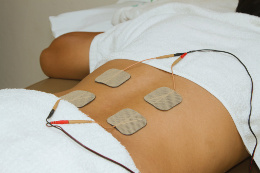Myofascial pain syndrome is a chronic condition that affects the fascia or the soft tissue that surround the muscles. It could affect a single muscle or a muscle group. This Buzzle write-up provides information on this condition.

Myofascial pain syndrome, which is also referred to as chronic myofascial pain, is a condition that causes chronic pain. It affects the muscles and fascia, which is a band of fibrous connective tissue that surrounds the muscles. It is characterized by the presence of sensitive areas or points in the muscles known as 'trigger points'. These points can be active, which means that these are always sore, and adversely affect one's ability to perform normal activities. An active trigger point lies within the skeletal muscle, and is associated with a local or regional pain. Pressure on these active points or areas of extreme tenderness can cause referred pain. The term 'referred pain' means pain that is experienced at a place in the body that is different from the part of the body that is injured or affected.
Latent trigger point is a dormant point, which has the potential to flare up. In case of latent trigger points, pain is not felt while performing normal activities. However, the points could get activated when the muscle gets strained or injured. A secondary trigger point is an irritable spot in the muscle, which can become active due to a trigger point and overload in another muscle. A satellite trigger point is a highly irritable spot in a muscle that becomes inactive, as the muscle lies in the region of another trigger point.
Contributing Factors
This condition could occur due to:
➻ An injury to a muscle
➻ Excessive strain on a certain muscle or muscle group, ligament, or tendon
➻ Injury to the intervertebral disc
➻ Jobs that involve repetitive motions
Lack of activity for a certain muscle group can stiffen the muscles, thereby aggravating this syndrome.
Symptoms
Pressure on these sensitive areas causes pain. In case of active points, pain is felt on touching the point. The pain might also spread through the entire muscle. Myofascial pain syndrome is characterized by the following symptoms:
➻ Deep, aching pain in a particular muscle
➻ Referred pain
➻ Pain that persists and worsens with time
➻ Pain that worsens with stress
➻ Muscle stiffness accompanied by joint stiffness in the affected area
➻ Knot in the muscle or a tight spot, which is often sensitive to touch
➻ Difficulty in sleeping or disturbed sleep due to the pain
➻ Muscle weakness
Individuals affected by this condition could also experience:
➻ Fatigue
➻ Depression
➻ Behavioral problems
Treatment
Physical therapy is the most preferred method to treat this condition. Performing stretches or strengthening exercises can prove beneficial. Also, postural training can also help.
Stretch and Spray technique involves spraying of the muscles and trigger points with coolants, after which the muscle has to be stretched slowly. Application of heat has also been known to provide relief from pain. Massage therapy also helps provide relief to the aching muscles, and also promotes healing. In certain severe cases, doctors might recommend the administration of a local anesthetic to the trigger points. This will bring the pain under control.
It is believed that myofascial pain syndrome could put one at a risk of developing fibromyalgia, which is a condition that is characterized by widespread musculoskeletal pain or hypersensitivity. So, it is important to diagnose and treat the myofascial pain syndrome at the earliest.
Disclaimer:
The information provided in this article is solely for educating the reader. It is not intended to be a substitute for the advice of a medical expert.


 Myofascial pain syndrome, which is also referred to as chronic myofascial pain, is a condition that causes chronic pain. It affects the muscles and fascia, which is a band of fibrous connective tissue that surrounds the muscles. It is characterized by the presence of sensitive areas or points in the muscles known as 'trigger points'. These points can be active, which means that these are always sore, and adversely affect one's ability to perform normal activities. An active trigger point lies within the skeletal muscle, and is associated with a local or regional pain. Pressure on these active points or areas of extreme tenderness can cause referred pain. The term 'referred pain' means pain that is experienced at a place in the body that is different from the part of the body that is injured or affected.
Myofascial pain syndrome, which is also referred to as chronic myofascial pain, is a condition that causes chronic pain. It affects the muscles and fascia, which is a band of fibrous connective tissue that surrounds the muscles. It is characterized by the presence of sensitive areas or points in the muscles known as 'trigger points'. These points can be active, which means that these are always sore, and adversely affect one's ability to perform normal activities. An active trigger point lies within the skeletal muscle, and is associated with a local or regional pain. Pressure on these active points or areas of extreme tenderness can cause referred pain. The term 'referred pain' means pain that is experienced at a place in the body that is different from the part of the body that is injured or affected.